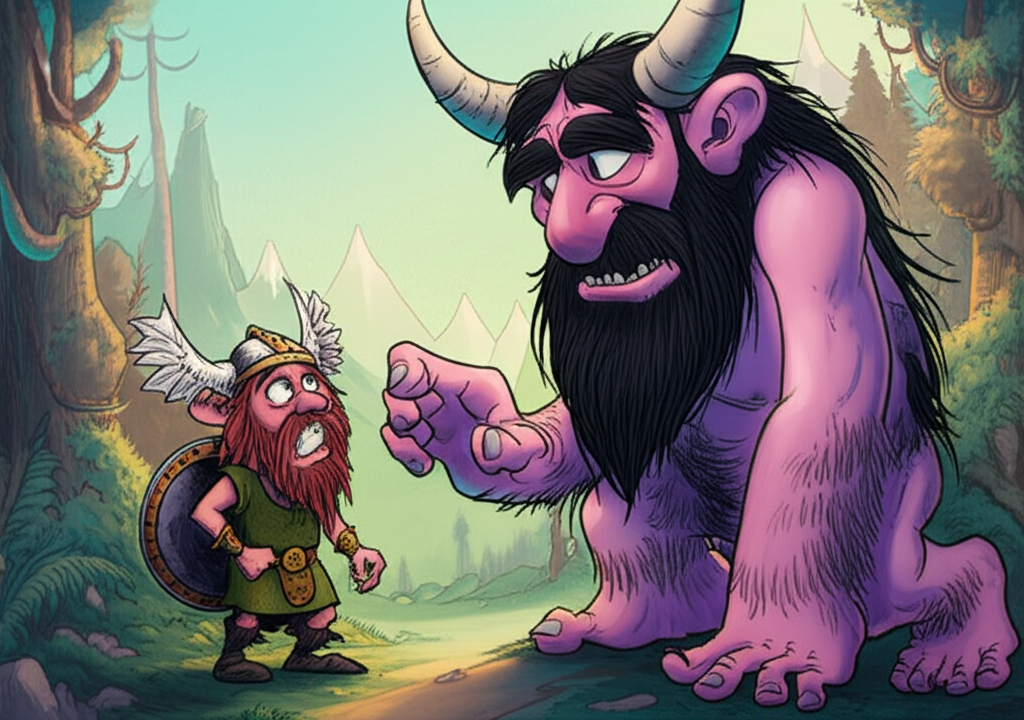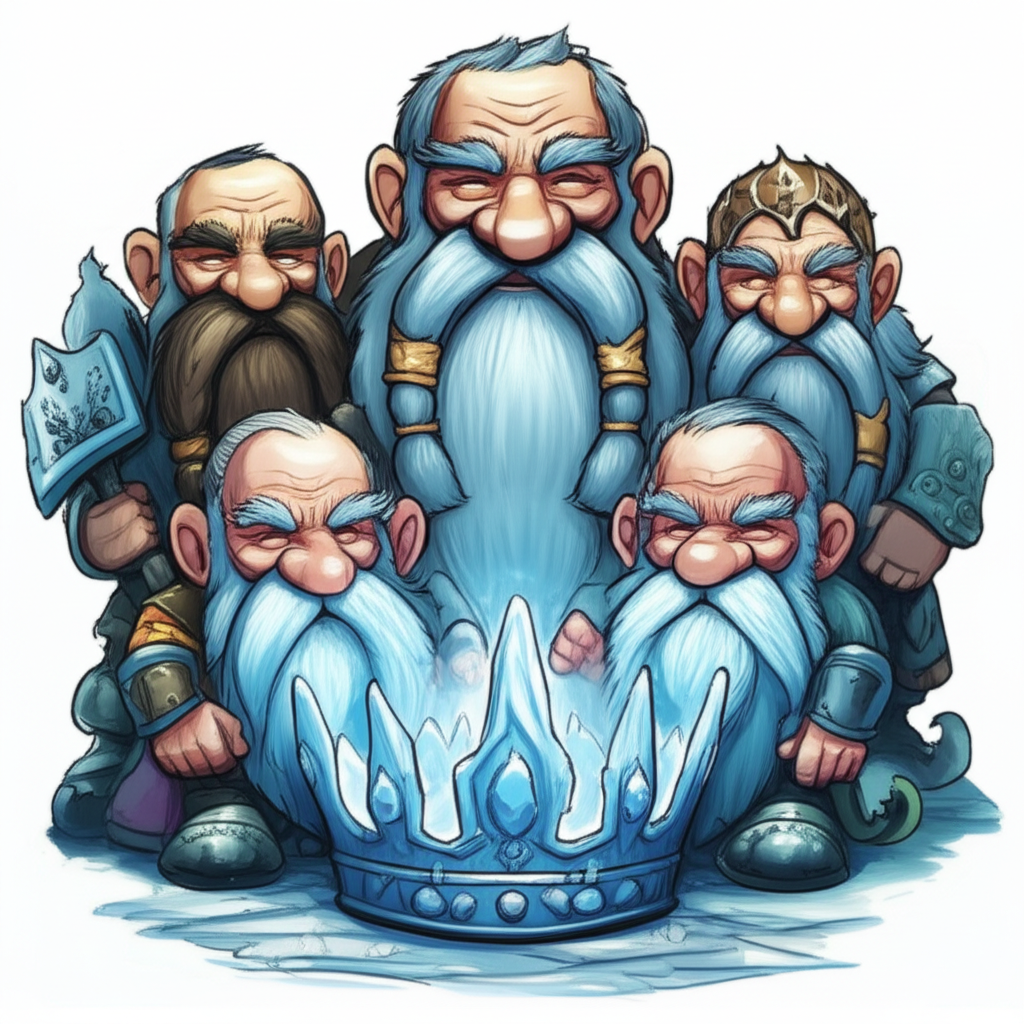1. Introduction
The tale of Bragi and the Trial of Ragnarök emerges from the rich tapestry of Norse mythology, a collection of traditional stories shared by the ancient Germanic peoples of Scandinavia and Iceland. These narratives, passed down through generations, offer a fascinating glimpse into the worldview of communities existing centuries ago. It is crucial to understand from the outset that this is a product of human imagination—a traditional story told by ancient people to make sense of their world—and is not meant to be believed, worshipped, or practiced as a religious truth. This particular narrative, while drawing upon established figures and concepts from Norse lore, interprets the idea of a "trial" not as a formal judgment, but as a profound poetic articulation of the inevitable cosmic doom known as Ragnarök, orchestrated by the god of poetry himself, Bragi.
2. Origins and Cultural Background
The myths of Bragi, Ragnarök, and the pantheon of Norse gods flourished during the Viking Age and the centuries preceding it, in a harsh yet awe-inspiring environment defined by vast forests, rugged coastlines, and unforgiving winters. The people who forged these stories were farmers, warriors, seafarers, and artisans, living in a society that valued courage, honor, and the spoken word. Their world was perceived as a delicate balance between order and chaos, constantly threatened by giants, monsters, and the cold void.
Their worldview was deeply cyclical, embracing concepts of creation, destruction, and eventual rebirth. They believed in a cosmic tree, Yggdrasil, connecting nine realms, and a complex web of fate, or "wyrd," that even the gods could not escape. Death was not always an end, but often a transition, particularly for warriors destined for Valhalla. In this environment, storytelling was not mere entertainment; it was a vital means of preserving history, transmitting cultural values, and understanding their place in a world filled with both wonder and peril. Myths like Ragnarök, the ultimate twilight of the gods, provided a framework for understanding cosmic cycles and the inevitability of change, imbued with a sense of fatalistic grandeur.
3. Character Description: Bragi, the Golden-Tongued Skald
Within this complex mythological framework, Bragi stands as a unique and revered figure. He is known as the skaldic god, the deity of poetry, eloquence, and music. Unlike Thor with his hammer or Odin with his spear, Bragi’s power resides in his voice and his mastery of verse. He is often depicted with a long, flowing beard, a symbol of wisdom and age, and is frequently associated with a harp or lyre, the instruments through which his divine melodies and sagas are conveyed.
Bragi’s most distinguishing attribute is his "golden tongue," signifying not only his eloquence but also the sacred nature of his words. He is said to have drunk from the Mead of Poetry, granting him unparalleled skill in verse. Symbolically, Bragi represents the profound power of language and storytelling. To the ancient Norse, he embodied the cultural memory of their people, the preservation of their history, heroes, and traditions through song and saga. He was the inspirer of skalds (poets) and a reminder that even in a world dominated by physical prowess, the artistry of words held immense value, capable of immortalizing deeds and shaping understanding. Bragi’s role was to record, to celebrate, and to articulate the truths of their existence, making him an ideal figure for a narrative centered on a "trial" of cosmic consequence.
4. The Main Story: Bragi and the Trial of Ragnarök
As the threads of fate began to fray and the signs of Ragnarök—the final doom of the gods—grew undeniably clear across the Nine Realms, a somber mood descended upon Asgard. The Fimbulwinter had stretched for three years, wolves hunted the sun and moon, and the bonds holding ancient evils were weakening. In the grand halls of Valhalla, amidst the feasting and the preparations for the final battle, a deep unease settled upon the gods. They knew their doom was approaching, prophesied by the Volva, yet the sheer enormity of it, the tapestry of their collective demise, remained an abstract dread.
It was Odin Allfather, weary and burdened by foresight, who called upon Bragi. "Golden-tongued Bragi," Odin’s voice rumbled, echoing through the great hall, "the time of our end draws nigh. We know the prophecies, the warnings woven by the Norns, yet the truth of it, the inescapable verdict, remains a murmur in the wind. I task you now with the greatest skaldic feat ever conceived: to weave the entirety of Ragnarök into a single, cohesive saga. Let your poetry be the trial, Bragi. Let your words be the judgment, laying bare the truth of our fate, not for us to change it, but to comprehend it fully before the darkness descends."
Bragi, with a grave nod, took up his ancient lyre, its strings resonating with the weight of ages. He stood before the assembled gods and goddesses—Thor, Freyja, Tyr, Heimdall, and many others—their faces etched with a mixture of apprehension and grim resolve. Bragi’s voice, usually a source of joyous verse and heroic sagas, now deepened, taking on the resonance of the very earth.
He began not with battle, but with the whispers of creation, the primal void of Ginnungagap, and the birth of the first beings, tracing the lineage of both gods and giants. With each verse, he painted vivid pictures: the joyous construction of Asgard, the forging of Mjolnir, the playful innocence of Baldur. But as his narrative progressed, the shadows lengthened. He recounted the binding of Fenrir, the casting of Jörmungandr into the sea, the trickery of Loki that led to Baldur’s death—each act a contributing factor, a necessary step in the cosmic progression towards the end.
Bragi’s performance was not merely a recitation; it was an immersive experience. His voice shifted, mimicking the howl of the Fenris wolf, the hiss of the Midgard Serpent, the roar of the fire giant Surtr. The air in Valhalla grew heavy with the smell of smoke and impending battle as he sang of the breaking chains, the crumbling bridges, and the clashing armies. He described the final stand of Odin against Fenrir, Thor’s valiant duel with Jörmungandr, Freyja’s sorrow, and Heimdall’s last, piercing call upon Gjallarhorn.
The gods listened in stunned silence, their faces reflecting the unfolding tragedy. Bragi’s poetry was so potent, so vivid, that they did not merely hear of Ragnarök; they felt it. They witnessed their own doom, not through prophecy, but through the undeniable, artistic truth of Bragi’s verses. This was the "trial"—not one of appeal or alteration, but a profound, inescapable verdict delivered through the medium of sacred verse. It judged not their guilt, but their destiny, making their inevitable end a tangible, heartbreaking reality. When Bragi’s final note faded, a silence heavier than any battle descended. The gods stood, not in despair, but with a newfound, chilling clarity, ready to face the fate that Bragi’s golden tongue had so eloquently, so terribly, articulated.
5. Symbolism and Meaning
To the ancient Norse, this mythological "Trial of Ragnarök" by Bragi would have carried profound symbolic weight. It underscored the inescapable nature of fate (wyrd), a concept central to their worldview; even the gods, with all their power, could not alter their destined end, only face it with honor. Bragi’s role emphasized the immense power of storytelling itself – how sagas, poems, and oral traditions preserve history, transmit cultural values, and make sense of life’s greatest mysteries, including death and cosmic renewal.
The narrative also reflects the cyclical view of time prevalent in Norse thought: Ragnarök is a cataclysmic end, yet it clears the way for a new world to emerge, signifying destruction as a necessary precursor to creation and rebirth. Furthermore, Bragi, as the chronicler, represents the human need to understand and articulate profound truths, even grim ones. His poetry provides a lens through which chaos can be comprehended, offering a form of order and meaning even in the face of cosmic annihilation. It speaks to the idea that knowledge, even of impending doom, can offer a form of wisdom and acceptance.
6. Modern Perspective
Today, Norse mythology, including figures like Bragi and the grand narrative of Ragnarök, continues to captivate and inspire. It is interpreted and reinterpreted across various modern cultural mediums, stripped of its original religious context and appreciated for its narrative depth and archetypal power.
In literature, authors like Neil Gaiman have reimagined these myths in works such as "Norse Mythology," bringing ancient tales to new audiences. The Marvel Cinematic Universe, through its "Thor" films, has popularized many Norse gods and concepts, albeit with significant creative liberties, making figures like Odin, Loki, and the concept of Ragnarök household names. Video games, such as the critically acclaimed "God of War" series and "Assassin’s Creed Valhalla," immerse players in the world of Norse mythology, allowing them to interact with its landscapes, creatures, and characters.
Academically, these myths are studied within cultural studies, comparative mythology, and history, offering insights into ancient Germanic societies, their values, fears, and hopes. Bragi’s role, in particular, resonates with contemporary discussions about the power of narrative, the preservation of cultural heritage, and the enduring human need to create and share stories, even in an increasingly digital age. The themes of heroism, destiny, apocalypse, and rebirth continue to resonate deeply, reflecting universal human experiences and anxieties.
7. Conclusion
The story of Bragi and the Trial of Ragnarök, like all myths, is a testament to human imagination and the enduring power of storytelling. It is a traditional narrative from an ancient culture, not a divine truth, and is presented solely for its cultural, historical, and educational value. As Muslims, we recognize that only Allah is the true Creator and Sustainer, the One without peer or partner, and that these captivating stories are products of human ingenuity and cultural heritage, reflecting the diverse ways people have sought to understand the cosmos and their place within it. They stand as a rich legacy of human thought, offering profound insights into the minds and societies of those who first conceived them, and reminding us of the timeless tradition of sharing imaginative tales across generations.





